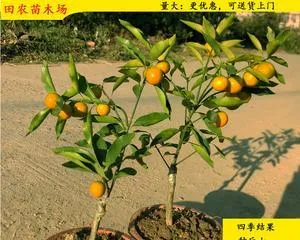The bonsai orange tree is a plant that can not only be appreciated for its beautiful scenery but also bring good luck. However, if pruning is not paid attention to, its growth will become messy, affecting its ornamental effect. How can we keep the bonsai orange tree in an elegant posture? Next, we will introduce the pruning techniques for bonsai orange trees.

Understanding the Growth Patterns of Bonsai Orange Trees
Before pruning, it is first necessary to understand the growth patterns of bonsai orange trees. Generally speaking, new branches of the orange tree grow from the top of old branches, and flowers and fruits bloom at the top of the new branches. When pruning, it is important to retain new branches to ensure the normal growth of flowers and fruits.
Formative Pruning
Formative pruning refers to the overall pruning and shaping of the bonsai orange tree. It can make the shape of the bonsai orange tree more beautiful and more in line with ornamental needs. Generally, in the early growth stage of the orange tree, formative pruning can be used to reduce branches and trim the canopy to form a beautiful and symmetrical shape.

Thinning Pruning
Thinning pruning refers to the partial pruning and thinning of the bonsai orange tree. It mainly involves removing overly dense or crossing branches to ensure an even distribution of branches and leaves, allowing light to better penetrate the interior of the plant and promote the growth of flowers and fruits. At the same time, thinning pruning can also effectively prevent the occurrence of pests and diseases.
Removing Diseased and Pest-Infested Parts
During the growth of a bonsai orange tree, it is often attacked by pests and diseases. If not dealt with in time, it will seriously affect the growth of the plant. When pruning, special attention should be paid to removing diseased and pest-infested parts. If diseases such as anthracnose or powdery mildew are found, the affected fruits, branches, and leaves should be completely removed.
Removing Dead Branches and Withered Leaves
The bonsai orange tree is quite resilient and can maintain a certain level of growth even without pruning for a long time. However, long-term lack of pruning can lead to the withering and balding of the bonsai orange tree. When pruning, special attention should be paid to removing dead branches and withered leaves. This not only provides a better growing environment for the plant but also enhances the appearance of the bonsai orange tree.

Controlling the Direction of Branch Growth
When performing formative pruning, it is also important to control the direction of branch growth. Generally, new branches should be encouraged to grow outward to avoid tangling and crossing. If branches are found growing crosswise, thinning pruning should be carried out in time to ensure the healthy growth of the plant.
Pruning After Retaining Flowers and Fruits
The flowers and fruits of the bonsai orange tree are beautiful, but their weight can affect the plant's balance and stability. While retaining flowers and fruits, corresponding pruning work must also be done. For example, the center of gravity of the plant can be lowered by removing small branches and buds from the upper part of flowering branches, which also promotes the growth of flowers and fruits.
Appropriately Reducing the Burden on Branches
During the growth of the bonsai orange tree, the number and length of branches will continuously increase. If not pruned in time, it will increase the burden on the plant. When pruning, it is necessary to appropriately reduce the burden on the branches. For example, by removing some redundant branches, the weight of the plant can be reduced, allowing it to grow better.
Regular Pruning
The bonsai orange tree is a vigorous plant that requires regular pruning to maintain its beautiful shape. Generally, spring and autumn are the best times to prune bonsai orange trees. During these two seasons, the plant grows faster and can recover easily after pruning.
Paying Attention to Water Supply
Bonsai orange trees need sufficient water to maintain growth. When pruning, special attention should be paid to the water supply. If there is insufficient water, it will affect the growth of the plant, preventing it from recovering normally.
Maintaining a Humid Environment
The bonsai orange tree is a plant that prefers a humid environment. When pruning, it is important to maintain a humid environment. The humidity around the plant can be maintained by regular misting, which helps the plant absorb nutrients better and promotes growth.
Focusing on Fertilizer Supply
Bonsai orange trees need sufficient nutrients to maintain growth. When pruning, it is important to focus on fertilizer supply. Fertilizing the plant after pruning can promote its growth and increase its resistance.
Avoiding Strong Sunlight
The bonsai orange tree is a shade-loving plant, and excessive sunlight can damage it. When pruning, avoid placing the bonsai orange tree in direct sunlight. Pruning can be done under a tree shade or indoors to ensure the healthy growth of the plant.
Using Professional Tools
Pruning bonsai orange trees requires professional tools such as scissors and pruning saws. When using tools, pay attention to safety to avoid cutting yourself or damaging the bonsai orange tree.
Through pruning and trimming, the bonsai orange tree can not only maintain a good growth state but also beautify its appearance and increase its ornamental value. Attention must be paid to formative pruning, thinning pruning, removing diseased and pest-infested parts, controlling the direction of branch growth, appropriately reducing the burden on branches, pruning after retaining flowers and fruits, regular pruning, and focusing on water and fertilizer supply to ensure the bonsai orange tree grows healthily and vigorously.